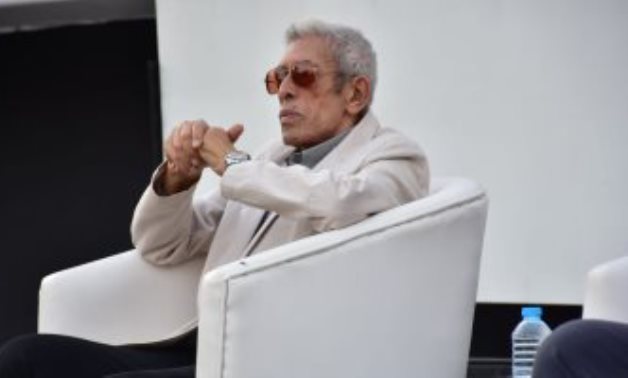
File: Daoud Abdel Sayed during CIFF seminar.
It is hard to believe that it’s been 30 years since the release of Daoud AbdelSayed’s era-defining film ‘El Kit Kat.’
Celebrating the film’s 30th anniversary, Cairo International Film Festival held a riveting roundtable discussion on November 29.
In September 1991, late actor Mahmoud Abdelaziz’s blind but all-knowing, sly but tragic, Sheikh Hosny burst onto cinema screens across the country, surprising even the film’s creators with its success.
El Sayegh, spoke about AbdelSayed’s light hand as a director. “There was trust in the actors he had chosen; he would let us do our thing and when he needed to, would step in with one perfectly-crafted question to guide us back where we needed to be.”
There is resulting ostracism, everyone is already naked.
Visionary director Daoud Abdel Sayed shared the stage with the film’s set designer Onsi Abou Seif, director of photography Mohsen Ahmed, composer Rageh Daoud, and actor Ahmed Kamal, as well as film critic and discussion moderator Mahmoud Abdel Shakour.
‘El Kit Kat’ is, fundamentally, an urban ensemble drama, as much about the neighborhood it’s named for as it is the people who reside in it.
But tellingly, it was almost not named for the neighborhood at all.
AbdelSayed shared that he still believes the original title, ‘Naked in the Crowd’ (‘Araya Fel Zeham’), is a more authentic representation of the film. “In popular neighborhoods like this, there’s nowhere to hide. Everyone knows everything about everyone.You open window and can reach out to shake your neighbor’s hand; the community is one.”
One of this film’s other enduring legacies is its set design, exemplified in the film’s dedication “to the artist of Egyptian cinema, Onsi Abou Seif,” Ahmed Kamal highlighted.
Abou Seif, the team reflected, studied the neighborhood so rigorously that the scenes shot in his constructed set blend seamlessly with those shot in ‘El Kit Kat.’ Audiences, Abdel Shakour reflected, couldn’t tell which was which, and were surprised to hear the set design being celebrated when they couldn’t tell it was designed at all.
Abdel Shakour opened the discussion with a small but telling question to the audience: was anyone old enough to have seen the film in cinemas? The filled-out amphitheater collectively shook its head. The audience of the panel was almost entirely young, representative of a new generation that is not only in tune with, but inspired by, the years of cinema before them. They sat in rapt attention, hanging onto every word as the panel reflected on the process of making the film so many years ago.
Claustrophobic, yes, but AbdelSayed said he was also communicating something liberating about the urban fabric. When every secret is public knowledge, an inevitable sympathy takes hold of the community. And there is a certain acceptance and belonging in that. That’s also the secret behind the climactic scene of the movie: when Sheikh Hosny airs everyone’s dirty laundry to the neighborhood via a forgotten microphone,
Meticulously constructed and artfully directed, the film is above all, according to AbdelSayed, a rumination on helplessness. Sheikh Hosny is disabled but refuses to accept it, Sherif Mounir’s Youssef is fundamentally passive, Aida Riad’s Fatma is defined by frustrated desire. This is exactly what legendary composer Rageh Daoud emulated in the film’s iconic music, in a visionary blend of instruments. “We decided to blend the organ—with its rich, dread-inducing sound associated with hallowed halls—and its opposite, the light gentle sound of the “oud.” Two very different civilizations come together to exemplify the central tension of the film: the pull between helplessness and desire.”
Comments
Leave a Comment